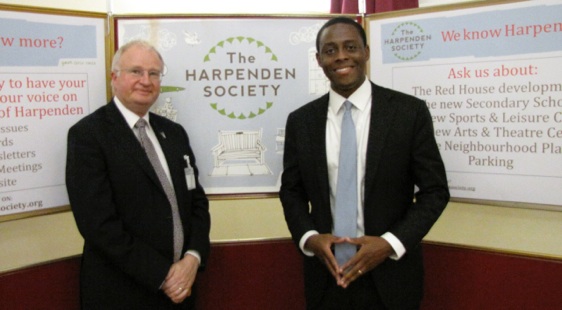The Harpenden Society
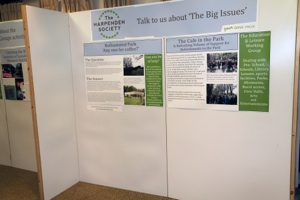
TOWN MEETING BACKS CIVIC SOCIETY’S APPROACH TO PROPOSED HOUSING PLANS
A packed meeting in Harpenden on Thursday 12 June unanimously agreed a motion to protect against excess development in the town.
The meeting was called by The Harpenden Society to discuss the implications of likely proposals to build 9,000 houses in the St Albans District over the coming years.
Chris Marsden, Chairman of The Society, asked for and received the audience’s approval for two key policy actions. Firstly, that Green Belt land should only be released if the legal condition of ‘only in exceptional circumstances’ was fully justified. Secondly, that recognition of the infrastructure shortfalls in any development would be acknowledged and decisively met. The motion reflected the argument about the pressure on local facilities, such as roads and schools, and the value of the Green Belt by The Society spokesperson, Joanne Whitehead. Her concise analysis and proposals were greeted with prolonged applause.
The other panellists included Councillor Julian Daly, Leader of the District Council and planning portfolio holder, and Mike Peters, CEO of Jarvis Homes. Cllr Daly described the complexity of the problem faced by the District Council and the need to produce a ‘defensible position’ in response to demands from national government to build many more houses. Mike Peters described how, without an agreed local development plan, developers would enjoy a free-for-all.
The discussion included time for questions and answers which attracted a strong interest in infrastructure issues such as the pressure on water supply.
Chris Marsden said “we have done what we set out to do. We have given a chance to the people of Harpenden to hear from a local councillor, a local developer and our own representative their views on the forthcoming Strategic Housing Plan for the District. People came, they listened, they asked questions, they made comments, and then they gave their wholehearted support to how we should plan our future actions.”
Below. The three speakers for the evening from l2r: Cllr Julian Daly Portfolio holder for planning & conservation St Albans District Council.
Joanne Whitehead Harpenden Green Belt Association.
Mike Peters CEO Jarvis Homes and Jarvis Commercial
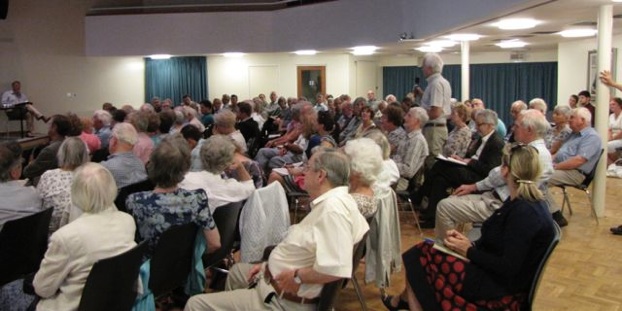
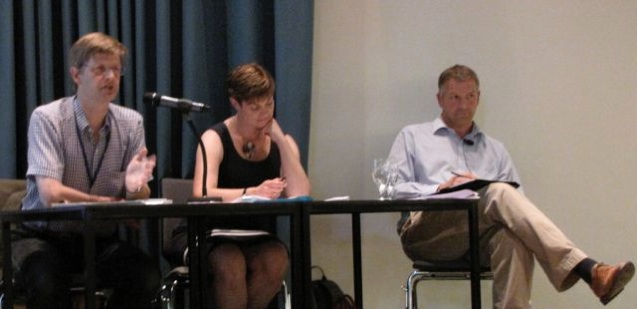
Extra opening hours at Harpenden Library thanks to volunteers from The Harpenden Society
Harpenden Library will continue to open on Wednesday afternoons thanks to volunteers from the Harpenden Society.
Since January 2014, Harpenden Library and the Harpenden Society have worked together to increase access to the town’s High Street library. The six-month pilot scheme has been so successful that it will be extended.
Volunteers from the Harpenden Society staff the ‘Library Express’ self-service area from 1pm to 7pm on Wednesdays – offering an additional 6 hours of library opening time for anyone wanting to return or borrow items from the Library Express area.
Frances Button, Cabinet Member for Libraries, said: “Hertfordshire County Council has been able to make savings to the libraries budget without closing any branches. I am very pleased that we have been able to extend access to libraries through innovative partnerships, such as this highly successful pilot scheme at Harpenden Library.
“I’d like to thank the volunteers from Harpenden Society who’ve helped keep the library open for an additional afternoon.”
Chris Marsden, Chair of the Harpenden Society, said: “Actions speak louder than words. We believe in the community getting involved in supporting community assets – and this is practical working model of that idea. We are delighted that our partnership with the library service has proved to be both smooth and effective.”
Before moving to the High Street, Harpenden Library was open for 37 hours a week. The introduction of Library Express, plus the additional volunteer-staffed hours mean that people can now access the library 57 hours a week.
For more information about Hertfordshire Libraries visit www.hertsdirect.org/libraries
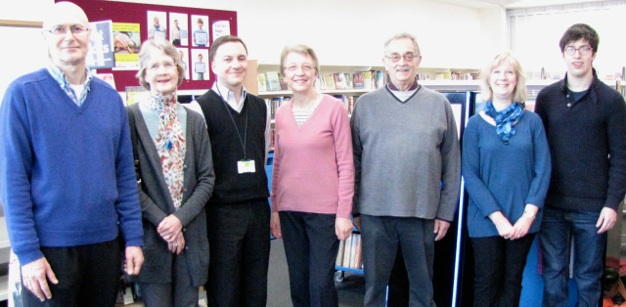
HARPENDEN AND THE HOUSING CRISIS
The likely effect of the national housing crisis on Harpenden causes all serious minded citizens furiously to think. The furrowed brow rather than the cheery grin was thus the main feature on the countenance of the audience that attended The Harpenden Society hosting of a meeting to discuss this subject. Over 300 people crammed into the public hall on Monday 20 October to listen attentively to a long explanation by Councillor Julian Daly, leader of the St Albans and District Council and its planning portfolio holder, on why it is being proposed in the draft Strategic Plan to build 9000 housing units in the district over the next twenty years, 5000 on brown field sites and 4000 on green belt locations. It amounts to an average of 436 new homes every year. Councillor Daly was accompanied by Chris Briggs, a senior council officer.
For fully an hour and a half under the expert and fair-minded control of The Society’s chairman, Chris Marsden, members of the audience raised a battery of wide-ranging questions and comments, from the knotty legal, techical and demographic intricacies to more heartfelt pleas about the town’s capacity to cope with so heavy a building programme. Appropriate to the mood of the evening these points were made quietly, courteously and without rancour. Councillor Daly replied in like tones, although there was a derisory and incredulous flavour about the reaction to his assertion that the traffic on the main road through Harpenden had slackened of late. However, as Councillor Daly constantly reiterated, the draft plan may only be amended by the provision of strong evidence, not anecdotal or emotional sentiment.
And this the Chairman of The Society promised to do.
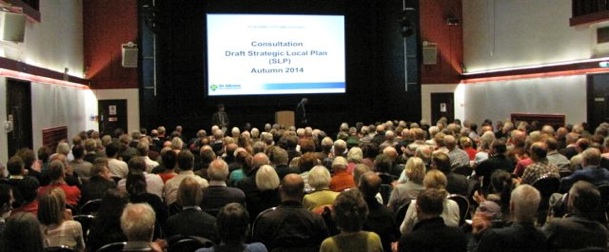
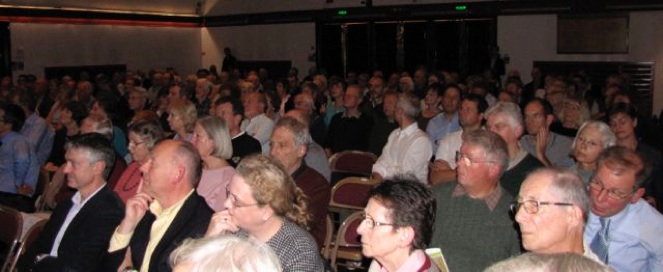
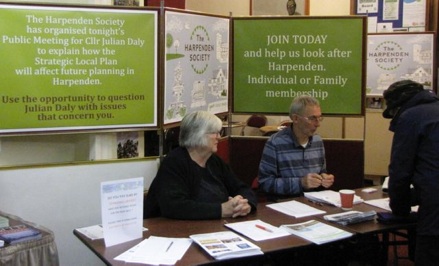
SADC Strategic Local Plan-Feed Back
The Public Consultation process closed on Sunday Nov 23. Approximately 4,000+ responses were recorded via the on line site, written responses and via the booklet. This from a population at the last census of just over 140,000 in St Albans, Harpenden, Redbourn, Wheathampstead and other locations.
That’s just under a 3.00% ratio of the total population. PLUS there were a number of Society, Association and Council responses.
Harpenden Town Council-- broad comments:
It deplores the loss of Green Belt Land.
The GB is a valuable asset providing benefits for the local population.
It recognises the high demand for housing in Harpenden,
This being a consequence of being an attractive place to live with good transport links and excellent schools.
There is an unmet need for older residents to downsize.
A need for affordable start up homes for key local workers.
A need for small family homes.
The 500 homes would not be feasible on site S5.
Harpenden is a dormitory town with limited employment growth potential.
The infrastructure requirements are not specified
There are many inaccuracies and inconsistencies in the details of the draft plan
You can read the full response by clicking here;
Harpenden Green Belt Association--broad comments
They have produced a 22 page document which is highly critical of the
Draft Plan in every aspect.
Their technical knowledge of property development and the laws governing this appear to be very sound.
They dispute any use of green belt and want SADC to investigate better use of brownfield sites
SADC should also be working together with other authorities to create new Garden Cities
They have pointed out huge discrepancies and inconsistencies in some of site proposals
They have highlighted the woeful inadequacy of SADC's infrastructure planning.
http://www.harpendengreenbelt.org.uk
http://www.harpendengreenbelt.org.uk
The Harpenden Society--broad comments
They have listed 5 key elements which disagree with the proposals in the Draft Plan, similar in content to the views of the the above.
http://www.harpendensociety.org
SUMMARY
All 3 responses deal with issues about Harpenden, as you would expect.
There did not appear to be any concerns about the whole of the SADC region.
The problems of the region are partly due to the failure to implement a new Local Plan several years ago. Harpenden and St Albans have a symbiotic relationship. A sound Plan will have benefits for the whole region and the young people who making their way in the world.
The current plan is the oldest in the Britain. Times are changing faster than ever. SADC is stuck in a time warp. If a new plan is not sorted soon Developers will ride roughshod over rules and regulations leading to a nightmare scenario.
Ron Taylor. Editor.



April 22. 2015 Exhibition and Prize presentation at The Harpenden Society Annual Creative Arts Competition for the town’s primary schools.
A report on The Harpenden Society organised meeting Feb 26 about the new Secondary School
THE CLOCK IS TICKING
Tuesday 17 March could be either a red or a black letter day for Harpenden children. It is the day when the government, in the shape of the Education Funding Agency, will say 'yes' or 'no' to the application to build a new and fourth secondary school in the town.
This was revealed at a public meeting on 'Schools; Locations and Places' organised by the Harpenden Society on Thursday 26 February. A panel of three speakers, Ben Bardsley,(below right) chairman of the Harpenden Parents Group, County Councillor David Williams (below centre) and Philip Waters, (below left) Secretary of the Harpenden Secondary Schools Trust (HSST) which has been responsible for formulating the application. The Trust is comprised of representatives of the three existing secondary schools, Rothamsted Research and the University of Hertfordshire.
The mood of the meeting was well-tempered but serious as parents tested the speakers with probing questions. The speakers left little doubt as to the enormity of the challenge. A six-form entry school of 1150 pupils is planned to meet the undoubted and mounting need for places. By 2020 the shortfall will in fact be for some 250 extra places, equivalent of an eight-form entry. If the application is approved it is planned for the school to open in 2017, although it was indicated that tha the first year of pupils might begin their studies before the whole of the development had been finished.
Although considerable work has been done in identifying possible sites, with the land cornering the Lower Luton Road and Common Lane the consultants' preferred option, the decision would be taken by the Education Funding Agency with planning permission dependant on the St Albans District Council. The problem is here and now; some 74 extra places will be required this year and a minimum of 120 by 2017.
The spectre was raised of what happens if the decision on 17 March is 'no'. The Hertfordshire County Council has an obligation to find places for all children and the answer was that they would be found – but elsewhere in the county not in Harpenden.

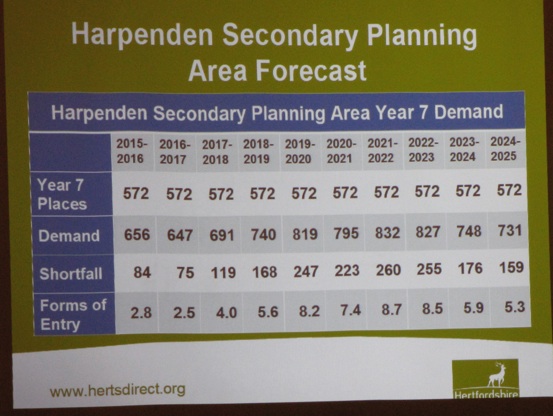
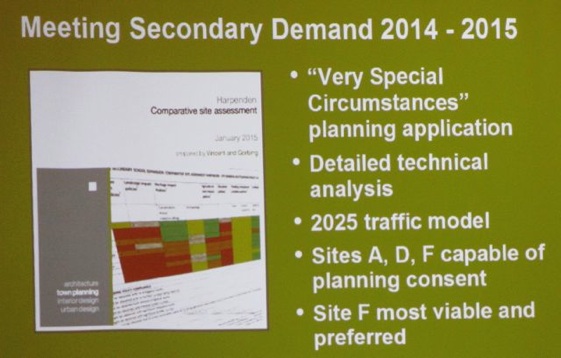
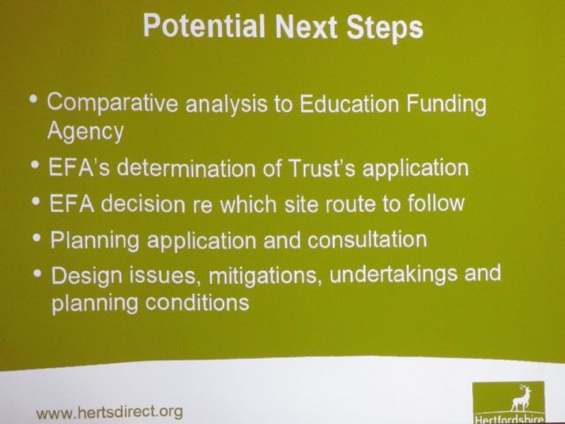

Airing Society members’ local concerns at Public Meeting - Dec 10
After some seasonal mulled wine and mince pies, members were invited, in an open forum invigilated by society chairman Chris Marsden, to air their concerns about local issues. Among those taking part, in what was a free-ranging and sometimes lively discussion, was Hertfordshire County and Harpenden Town councillor David Williams.
Car parking nightmares
On-street parking by commuters using Harpenden Station was ‘spreading’ ever further from the town centre. Clearly the fact that street parking was free had become a key inducement for those commuters willing to walk up to perhaps three-quarters of a mile to the station. From Monday to Friday, the station car parks were often full to capacity. That was an issue which, said David Williams, had been recognised for a decade or more by Network Rail (NR) and by local authorities.
Double-deck parking?
DW advised that NR had earmarked some £2 million back in 2013 for the erection of a ‘Meccano like’ double-deck structure on the east station car park. The plan, which would have increased parking capacity on that side of the station by about two thirds, required planning consent from St Albans District Council (SADC). And that was refused because of objections from residents in nearby Milton Road, even though the ground slopes steeply down from their back gardens, so that the proposed car park’s upper deck would be minimally intrusive.
Some surprise was expressed at the time that NR deemed it obligatory to submit its double-deck car park plans to SADC, when it had gone ahead with construction of the new station footbridge – an eyesore to much of Harpenden’s population – having considered planning consent unnecessary.
A separate problem afflicting the east station car park, that is the rush hour traffic and pedestrian congestion at its only (Station Road) entrance, was said to be under active consideration by NR and the local authorities. It was recognised that the situation could be eased by creating southern access to the car park, initially for pedestrians, via Crabtree Lane and Aysgarth Close. DW recommended members of The Harpenden Society and others to keep lobbying SADC on all the planning-related station car park issues.
One of those at the meeting suggested, as an alternative, or possibly in addition, ‘double decking’ Amenbury Lane car park, a proposal which would avoid the administrative complications of NR involvement, though posing a different question, namely how such a project would be funded.
‘School run’ congestion
Other parking issues raised at the meeting included the contentious matter of the ‘school run’, where all too many parents, usually mothers, wanted to drop their children outside school gates in the morning and pick them up at 3 or 3.30 in the afternoon, creating horrendous congestion. ‘Let them walk or use the school bus’ is the perennial cry. But it was pointed out that those are not always practical alternatives, most notably in the case of working mothers wanting to drive their offspring to school on their way to work.
Pedestrian/traffic ‘shared space’ conflict
Several contributors to the discussion raised the subject of the conflict between motorists and pedestrians in the town centre. The concept of ‘shared space’, exemplified by the same-level – ie ‘kerbless’ – block-paved areas along Lower High Street, where the roadway and the footpath are separated only by intermittent black cast-iron bollards, was called into question.
So too was the right-of-way priority, over pedestrians walking along Lower High Street, given to vehicles entering and leaving Vaughan Road, which conflicted with the allegedly shopper-friendly ‘shared space’ idea. No one at the meeting demurred from the suggestion that solid white lines across Vaughan Road, on either side of its crossroads with Lower High Street, would enhance pedestrian safety.
Pavement cyclists
Another pedestrian hazard raised at the meeting was that of cyclists riding on the footpath. Unquestionably against the law, it was something to which Harpenden’s rarely-seen police seemed to turn a blind eye. It was however acknowledged that cycling along the A1081 through today’s heavily-trafficked High Street brought its own separate dangers – for those on two wheels. The example of Holland as a ‘safe cycling nation’ was invoked, though Harpenden thoroughfares alas had no room to provide Dutch-style dedicated cycleways.
New secondary school
The informal debate then switched to the Harpenden area’s urgent need for more secondary school places, which could only be met by building a new school. Cllr Williams said the site for such a school – currently designated Green Belt –on the corner of Lower Luton Road and Common Lane, had effectively been finalised as the only viable and practical option. Although alternative sites had been considered, landowners were reluctant to sell relatively cheaply for school use, when a much higher price could be realised with house building in prospect.
Due to open in 2017, possibly in temporary buildings, the new secondary school would cater for children beyond just Harpenden itself, from Hertfordshire villages such as Kimpton and Ayot St Lawrence as well as, more obviously, from Wheathampstead and Redbourn.
James Marshall redevelopment
What was happening with the proposed redevelopment of the James Marshall home site behind the town hall? That was another question raised at the December meeting. Though the initial plans for an apartment complex submitted by the developer, Pegasus Life, were turned down, participating architect (and Harpenden Society member) Tim Riley said they had taken the proposals to planning appeal and the Planning
Arts ‘hub’ proposal
Numerous arts and crafts groups in and around Harpenden, including for example the town’s local history society, had long agitated for a cultural centre which would be available for meetings, exhibitions and other related events. At the December meeting it became clear that funding was a key obstacle. Expenditure by SADC on the recently-opened St Albans City Museum had largely drained the local public coffers.
However, Harpenden Society member (?) Hilary Taylor said the need was not so much for ‘physical’ premises, but for an ‘arts hub’ comprising a network of facilities available as and when required. It was agreed that the large space above the town’s library was presently very under-used by its nominally main occupier, Youth Connection (?), and could be much more fruitfully utilised by arts and cultural organisations.
Cllr Williams said the chances of obtaining worthwhile public funding for such an arts-related enterprise, though slim, would nevertheless be enhanced if active involvement by organisations in Wheathampstead, Redbourn and the smaller outlying villages could be assured.
END
Planning Controversy over Sainsbury’s Harpenden exterior vinyls resolved.
SADC Planning department had refused planning permission for the three vinyls that have been on display outside Sainsbury’s for several months on the grounds that they were deemed to be ‘advertising clutter’ and were ‘substantially injurious to the visual amenity of the subject building,

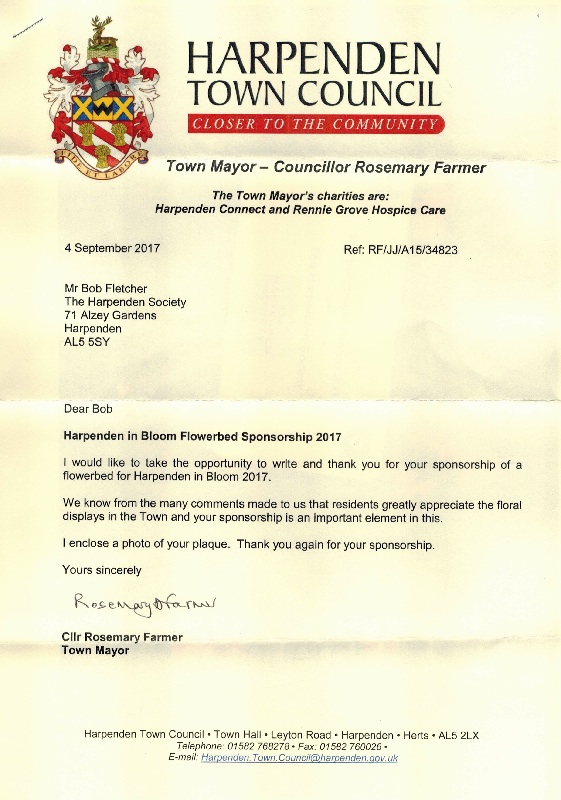
‘Housing plans need strategic
not ad hoc approach’, says
Harpenden’s new MP
Addressing an audience of over 100 of his constituents at a packed meeting of the Harpenden Society, the town’s new MP Bim Afolami (pictured above & below with Society chair Philip Waters) made a plea for a more strategic approach to planning challenges, rather than the ad hoc process which often resulted from local authority differences. He cited as an example St Albans District Council’s failure to consult with Dacorum in formulating its Strategic Local Plan, suggesting that in shaping the future of Harpenden there should be more collaboration between Hertfordshire County Council, SADC and the Town Council.
That was needed most notably, he said, if the question of supporting infrastructure – roads, schools and even medical services – was to be given due priority when major planning applications for new housing were submitted by developers.
It had to be recognised, said Mr Afolami, that more housing in and around Harpenden was needed. But if there was to be any chance of young people growing up in the town being able to afford a new home without moving away, the housing mix had to include 2/3-bedroom flats and houses – with supporting infrastucture. If the matter was not addressed then the prospect of a town which was more than just a ‘dormitory’, somewhere where people could live and work, with a feeling of real community, would be in jeopardy.
